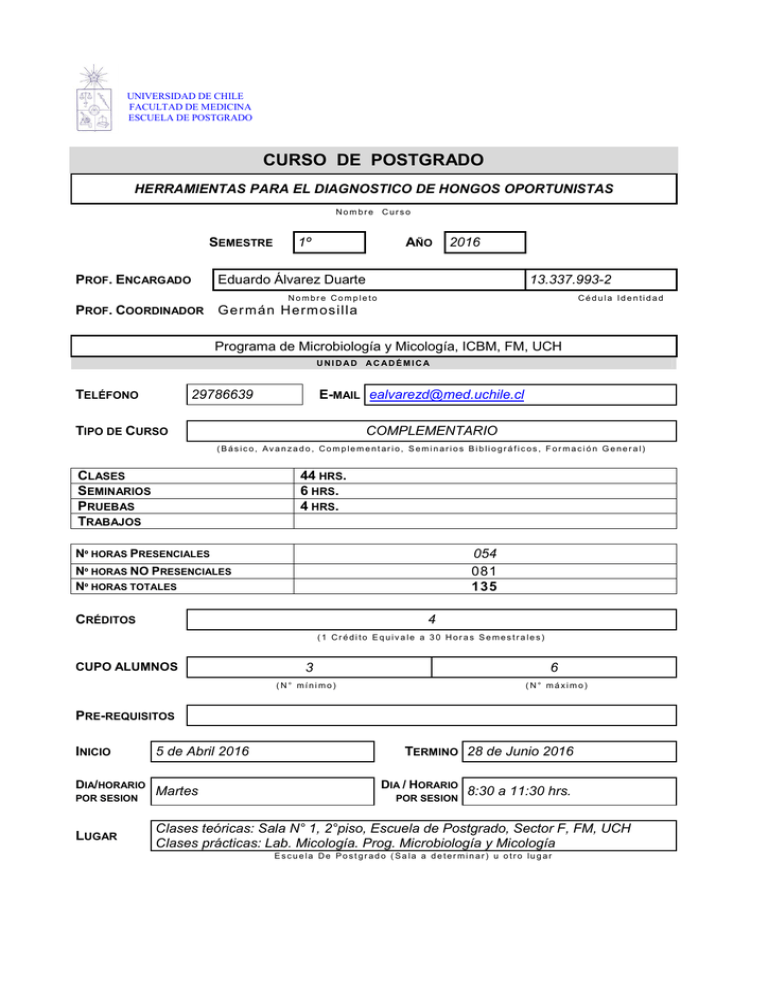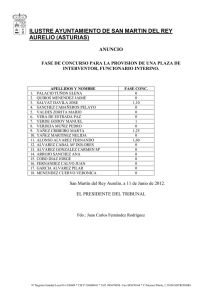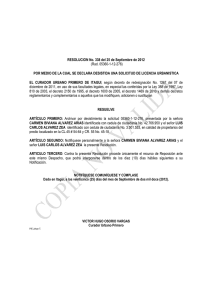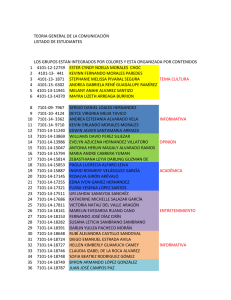CC Herramientas para el Diagnóstico de Hongos Oportunistas
Anuncio

UNIVERSIDAD DE CHILE FACULTAD DE MEDICINA ESCUELA DE POSTGRADO CURSO DE POSTGRADO HERRAMIENTAS PARA EL DIAGNOSTICO DE HONGOS OPORTUNISTAS Nombre SEMESTRE PROF. ENCARGADO 1º Curso AÑO 2016 13.337.993-2 Eduardo Álvarez Duarte Nombre Completo PROF. COORDINADOR Cédula Identi dad Germán Herm osilla Programa de Microbiología y Micología, ICBM, FM, UCH UNIDAD ACADÉMICA TELÉFONO 29786639 E-MAIL [email protected] TIPO DE CURSO COMPLEMENTARIO (B ás ic o, Av a n za d o , Co m p le m e nt ar i o, S emi n ari o s B i b li o grá f i c os , F or ma ci ó n G e ner a l) CLASES SEMINARIOS PRUEBAS TRABAJOS 44 HRS. 6 HRS. 4 HRS. 054 081 135 Nº HORAS PRESENCIALES Nº HORAS NO PRESENCIALES Nº HORAS TOTALES CRÉDITOS 4 (1 Cr é di to Eq uiv a le a 3 0 Hor a s Se mes tra le s) CUPO ALUMNOS 3 6 ( N° míni mo) (N° máximo) PRE-REQUISITOS INICIO DIA/HORARIO POR SESION LUGAR 5 de Abril 2016 Martes TERMINO 28 de Junio 2016 DIA / HORARIO POR SESION 8:30 a 11:30 hrs. Clases teóricas: Sala N° 1, 2°piso, Escuela de Postgrado, Sector F, FM, UCH Clases prácticas: Lab. Micología. Prog. Microbiología y Micología Esc u e la De Po st gr ad o ( Sa la a d e ter mi n ar) u o tro lu g ar METODOLOGÍA Clases teóricas, prácticas y seminarios (C las es , S e mi n ar i os , Pr á ct ic o s) EVALUACIÓN (INDICAR % DE CADA EVALUACION) Dos pruebas teóricas (30% cada una) una prueba práctica (30%) y seminario (10%) PROFESORES PARTICIPANTES (INDICAR UNIDADES ACADEMICAS) Eduardo Álvarez Duarte Germán Hermosilla Programa de Microbiología y Micología, ICBM Programa de Microbiología y Micología, ICBM DESCRIPCIÓN El presente curso está orientado a estudiantes de los programas académicos de postgrado, en el área de las Ciencias Biomédicas, Ciencias Médicas y a Programas de Formación de Especialistas, que requieren de conocimientos específicos en la disciplina de Micología. Durante el curso se trata en detalle procesos clásicos y moleculares referentes a la taxonomía y morfología de los hongos de importancia clínica, así como aspectos estructurales, fisiológicos, y relación agente-hospedero, entregando conocimientos integrales de la biología de los hongos. OBJETIVOS - Entender y reconocer las diferencias morfológicas entre los diversos grupos de hongos, enfatizando su taxonomía y clasificación. - Exponer al estudiante a las herramientas taxonómicas adecuadas para reconocer, clasificar e identificar en el laboratorio las especies más importantes en clínica. - Enumerar y resumir las técnicas utilizadas actualmente en la identificación y clasificación de los hongos. BIBLIOGRAFIA BASICA • Ainsworth, G. C. (1971). Ainsworth and Bisby’s Dictionary of Fungi. 6thEdn. Commonwealth Mycological Institute. Kew. • Ainsworth, G. C., F. K. Sparrow y A. S. Sussman (1973). The fungi: An Advanced Treatise. A taxonomic review with keys. Ascomycetes and Fungi Imperfecti. Vol. IVa. Academic Press. New York and London. • Barron, G. L. (1968). The genera of Hyphomycetes from soil. Williams &Wilkins Co. Baltimore. • Bisby, G.R. (1953). An Introduction to the Taxonomy and Nomenclalure of Fungi. Commonwealth Mycological Institute. Kew. • Kendrick, W.B. (ed.) (1971). Taxonomy of Fungi Imperfecti. University of Toronto Press. Toronto. • Kendrick, W.B. (ed.) (1979). The Whole Fungus. University of Toronto Press. Toronto. • Kendrick, W. B. (1992). The Fifth Kingdom. 2nd Edn. Mycologue Publications. Waterloo. BIBLIOGRAFIA RECOMENDADA • Carmichael, J. W., W. B. Kendrick, I. L. Conners y L. Sigler (1980). Genera of Hyphomycetes. The University of Alberta Press, Alberta. • Cole, G. T. y B. Kendrick (ed.) (1981). Biology of Conidial Fungi. Vol. 2. Academic Press. N. York. • Cole, G.T. y R.A. Samson (1979). Patterns of development in conidial fungi. Pitman. London. • Ellis, M. B. (1971). Dematiaceous Hyphomycetes. Commonwealth Mycological Institute. Kew. • Ellis, M.B. (1976). More Dematiaceous Hyphomycetes. Commonwealth Mycological Institute. Kew. • Gams, W., H. A. van der Aa, A. J. van der Plaats-Niterink, R. A. Samson y J. A. Staplers (1987). CBS Course of Mycology. 3rd Edn. Centraalbureau voor Schimmelcultures. Baarn. • Hawksworth, D. L., P. M. Kirk, B. C. Sutton y D. N. Pegler (1995). Ainsworth and Bisby’s Dictionary of Fungi. 8th Edn. International Mycological Institute, CAB INTERNATIONAL. Wallingford. • Hughes, S. J. (1953). Conidiophores conidia and classification. Can. J. Bot. 31: 577-659. • Kirk, P.M., P.F. Cannon, J.C. David y J.A. Stalpers (2001). Dictionary of the Fungi. 9th Edn. CAB INTERNATIONAL, Wallingford. • Matsushima, T. (1971). Microfungi of the Solomon Islands and Papua-New Guinea. Published by the author.Kobe. • Matsushima, T. (1975). Icones microfungorum a Matsushima lectorum. Published by the author. Kobe. • Minter, D. W., P. M. Kirk y B. C. Sutton (1982). Holoblastic phialides. Trans. Br. mycol. Soc.79: 75-93. • Minter, D. W., P. M. Kirk y B. C. Sutton (1983a). Thallic phialides. Trans. Br. mycol. Soc. 80: 39-66. • Minter, D. W., B. C. Sutton y B. L. Brady (1983b). What are phialides anyway ?. Trans. Br. mycol. Soc. 81: 109-120. • Minter, D. W. (1984). New concepts in the interpretation of conidiogenesis in deuteromycetes. Microbiol. Sci. 1: 4 86-89. • Saccardo. P. A. (1886). Sylloge Fungorum 4: 1- 807. • Sivanesan, A. (1984a). The bitunicate Ascomycetes and their anamorphs. Strauss & Cramer. Vaduz. • Subramanian, C.V. (1962). The classification of hyphomycetes. Bull. Bot. Surv. India 4: 249-259. • Tubaki, K. (1958). Studies on Japanese hyphomycetes. V. Leaf and stem group with a discussion of the classification of hyphomycetes and their perfect stages. J. Hattori Bot. Lab. 20: 142-244. • Tubaki, K. (1963). Taxonomic study of hyphomycetes. Ann. Rep. Inst. Fermentation Osaka 1: 25-54. CALENDARIO DE ACTIVIDADES (A continuación señalar : Descripción de la actividad, fechas, horas presenciales y no presenciales y Profesores a cargo) FECHA HORAS PRESENCI ALES HORAS NO PRESENCIAL ES DESCRIPCION ACTIVIDAD PROFESOR CT Introducción micología: generalidades E. Alvarez 5/4 3 4,5 12/4 3 4,5 12/4 3 4,5 19/4 3 4,5 26/4 3 4,5 CT Caracterización morfológica y molecular de hongos E. Alvarez 3/5 3 4,5 CT Genotipificación de hongos G. Hermosilla 10/5 3 4,5 Seminario I G. Hermosilla 17/5 3 4,5 Evaluación Teórica E. Alvarez 24/5 3 4,5 CT Agentes de micosis superficiales I TP Identificación de dermatófitos E. Alvarez 24/5 3 4,5 CT Agentes de micosis superficiales II TP Otros queratinofílicos E. Alvarez 31/5 3 4,5 CT Agentes micosis oportunistas I E. Alvarez 31/5 3 4,5 7/6 3 4,5 CT Agentes micosis oportunistas II TP Identificación de hongos filamentosos II E. Alvarez 7/6 3 4,5 CT Agentes micosis oportunistas III TP Identificación de hongos filamentosos III E. Alvarez 14/6 3 4,5 21/6 3 4,5 Seminario II E. Alvarez 28/6 3 4,5 Evaluación teórica II E. Alvarez 28/6 3 4,5 Evaluación Práctica Final del Módulo E. Alvarez TP Generalidades de hongos E. Alvarez CT Taxonomía hongos E. Alvarez CT Conidiogénesis E. Alvarez CT Métodos de identificación hongos levaduriformes TP Identificación de hongos filamentosos I CT Micosis subcutáneas TP Identificación agentes micosis subcutáneas G. Hermosilla E. Alvarez E. Alvarez


